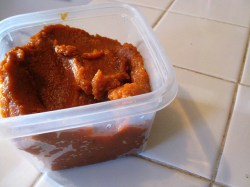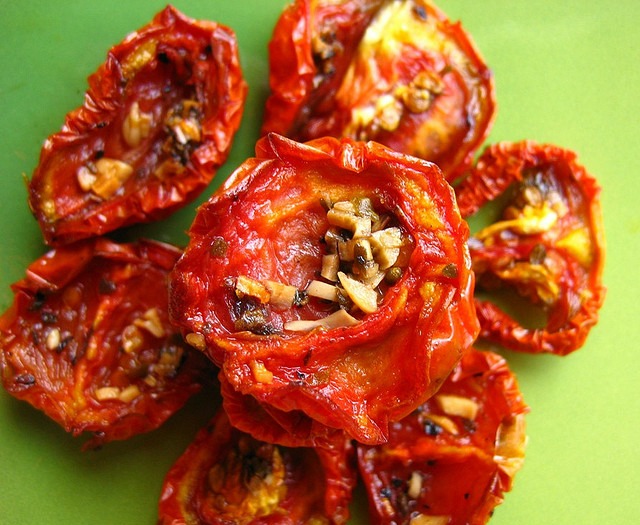
What to do with all these tomatoes? (Photo by Lionel & Heidi.)
It was a triumph: After three hours of chopping, pureeing, simmering, stirring, caramelizing, and concentrating, I stepped back from the stove. In my hand was a spoon, clinging to a dynamite-red flavor bomb. It was just short of nuclear, and already I knew I was going to put it into everything that could use a big bang of tart, savory, and sweet with a miles-deep umami finish. I showed it to my special lady friend. “Congratulations!” she said. “You just made tomato paste. It’s cheap and comes in cans.”
But but but … OK, fine. Yes, that is what this is. But to be honest, I’ve never understood, really, why anyone eats the tomato paste that comes in cans. I mean, I’m not even snobbing on this — it just tastes like sour goop; has anyone ever said, “You know, what this dish needs is some really sour red goop?”
This homemade tomato paste, though … this is magnificent stuff. Once you’ve concentrated three pounds of fresh, sweet, peak-summer tomatoes down to about a cup, you have a texture like cool butter and flavor that makes you feel like your brain might short-circuit: It’s tomato-y, sure, but it’s so tomato-y that it threatens to reform your idea of what a tomato tastes like altogether. The long, slow cooking simmers off all the water, making its flavor vibrate with intensity. But the cooking also starts to caramelize some of the sugars, giving its sweetness a darker, mysterious edge, and since I make it with some olive oil, the paste emulsifies a little to give a rich, round finish. Basically, it becomes a secret weapon for instant deliciousness — drop a spoonful in any sauce, any soup, sauté, salad dressing, or just smear it on something.
And since the cooking process concentrates the acid and boils off water, the stuff keeps well in the fridge for weeks, or in the freezer for months. I love to freeze it in little two-ounce containers, pulling one out every once in a while to have on hand whenever a dish needs to go bang!

Homemade tomato paste is nothing like the store-bought version. (Photo by Jenni Konrad.)
The bomb tomato concentrate
Makes about one cup
½ head garlic (optional)
1 medium onion (optional)
3 pounds super ripe, juicy tomatoes
¼ cup extra virgin olive oil
2 pinches salt
Cut, chop, puree: If using, mince garlic and onion in a food processor and reserve. Roughly chop tomatoes, and puree them to liquid in the food processor. (If you don’t have a food processor, no sweat. Just finely chop everything, and save as much of the tomato juice as you can.)
Warm oil: In a wide, heavy pot, warm the oil over medium-low heat. You want the pot to be wide so that the water evaporates more quickly. And you want it to be heavy to cook evenly without scorching (which will really ruin the paste, and your day). If using, add the garlic and onion and cook, stirring, until very soft, 15 minutes or so. Add a pinch of salt. If you want to go full-caramelize on the onions, hey, it’s your world.
Strain tomatoes (optional): If you’re unhappy with tomato skins and seeds, pass the pureed tomato through a fine-mesh strainer. (I won’t judge if you don’t bother.)
Cook tomatoes: Pour the tomato into the pot, turn heat up to high, and bring to a boil. Add a couple light pinches of salt. Reduce heat to a simmer, give it a stir, and wait. You’ll cook it for a long time, but it’s hard to say how long since tomatoes differ in water content. Bank on 90 minutes or more.
Wait: Wait.
Wait some more: Wait. And stir, too, more frequently as the tomato loses its juice and thickens. I use a heat-proof rubber spatula, since it clears the pot more thoroughly. Keep cooking and stirring. It’ll get thick and annoyingly splattery for a while, as it gets to a pizza-sauce thickness. You can partially cover the pot when that happens, then uncover it again when enough water’s boiled off so that it no longer splatters.
You’re almost there: When it starts to look pasty, you’ll notice that it’ll get stickier. Keep stirring, clearing the pot, mixing back in the thin, darkening layer at the bottom, and spreading the paste out. At some point, it may look like the oil wants to weep out; this is good. When the paste suddenly sticks together like a dough and slides around the pot, you’re done. Congratulations!
Store: Turn paste into a dish or bowl and let cool. Pack into containers, press a layer of plastic wrap directly on to the surface, and store in the fridge for weeks, or in the freezer for months. Stir into anything.
—
This is my other favorite way to preserve tomatoes: Dry them.
Now, if you lived through the ’80s, maybe you were scarred by Red Dawn: The Sundried Tomato Invasion. The only things more menacing than Soviet Russia were those chewy, insipid sour bits that showed up in everything.
But, like with tomato paste, making the stuff at home with real summer tomatoes gives you a totally different product altogether. You force all the tartness, sugar, aroma, and depth of the tomato into rings maybe a fifth of their normal size, turning decent tomatoes great and good tomatoes insane. It takes hardly any effort, and their tooth-stickiness turns into real pleasure, releasing more flavor with every chew. Chop them up and put them in, on, or around pretty much anything.

Oven-drying turns decent tomatoes great and good tomatoes insane. (Photo by The Purple Foodie.)
Oven-dried tomatoes
Makes about one cup of dried tomato slices
2 pounds fresh ripe tomatoes (any variety)
2 teaspoons olive oil, plus more to store, if desired
2 pinches salt
Preheat and slice: Preheat oven to 200 degrees, or thereabouts. Cut tomatoes into quarter-inch slices and lay them on a tray or two without any overlap. (A silicone mat, parchment, or nonstick baking sheet work nicely, but aren’t necessary.) Very lightly salt them, then dab a finger in the oil and lightly rub it onto the tomatoes, just enough to moisten them. Ew, that sounded grody.
Let the oven do its thing: Put the tomatoes in the oven for about 2.5 hours. Halfway or so into it, rotate the trays. Or forget to do it; it’ll probably be fine. They’re ready when they’re like fruit leather: dried, chewy, no visible juice but still a little pliable. If 2.5 hours doesn’t do it, keep checking on them every 15 minutes. If you want to speed it up, you can flip the tomato slices at some point.
Store: When they’re done, take them out and let the tomatoes cool on the tray. Store them in an airtight container. Chop and scatter them on anything your heart desires. It’s probably not necessary to keep them in the fridge, but I do, just in case there’s still some residual moisture left in them. You can cover them in olive oil, if you’d like, which will flavor the oil. They keep for months.



